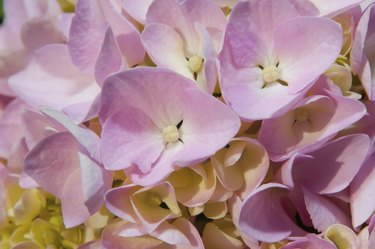
An area of diverse topography, Southern California goes from virtually frost-free areas in coastal areas to mountain ranges where snowy winters occur, including U.S. Department of Agriculture plant hardiness zones 5a through 11a. Average annual rainfall goes from around 3 inches for interior desert areas to 35 inches in the mountains. Hydrangeas (Hydrangea spp.), grown for their long-lasting, colorful flowers, are woodland plants native to North America and Asia. They prefer moist conditions.
Kinds of Hydrangeas
Video of the Day
Of the over 20 kinds of hydrangea, big leaf hydrangea (Hydrangea macrophylla) is probably best suited for Southern California. It's hardy in USDA zones 6 through 10, with two main types. Mopheads have large flower clusters in pink, red, blue, or purple, depending on the variety and the soil alkalinity. Lace cap types have flat flower clusters. Other species grown in Southern California include snowball or smooth hydrangea (Hydrangea arborescens), hardy in USDA zones 4 through 9 and oakleaf hydrangea (Hydrangea quercifolia), growing in USDA zones 5 through 9.
Video of the Day
Soil and Spacing
Garden hydrangeas need rich, fertile, well-draining soil. Before planting hydrangeas, amend the soil with organic material if necessary, mixing a 1- to 2-inch deep layer of well-aged compost into the planting site's soil. Hydrangea spacing depends on how you use the plant. For a specimen plant, give hydrangeas the maximum space for the particular species plus 1 foot of space around it.
For instance, mophead big leaf hydrangeas usually reach 3 to 6 feet wide, so allow a 7-foot-wide space. When planted as borders or hedges, space hydrangeas as far apart as that species' usual shrub width for a standard hedge. For quicker coverage or a denser hedge, plant them closer. For example, oakleaf hydrangea is normally 6 to 8 feet wide, so plant shrubs about 7 feet apart for a standard hedge or about 5 feet apart for a denser hedge.
Moisture and Watering
Even in mountainous areas with higher rainfall averages, Southern California has less rainfall than hydrangeas need. For example, big leaf hydrangea receives 50 to 60 inches of rain per year in the wild. From spring through fall, check each week, watering the hydrangea if the soil is dry, weekly if necessary. Keep the soil moist but not soggy. To conserve moisture, add 2 inches of mulch on top of the soil.
Best Light Conditions
In Southern California, hydrangeas do best in partial shade, since this helps keep soil moist and lessens the plant's water use. An east-facing or north-facing location is suitable except in coastal locations, where plants can tolerate full sun. Hydrangeas also do well under filtered shade of deciduous trees. Hydrangeas grow best with morning sun and afternoon shade.
How and When to Fertilize Hydrangeas
Hydrangeas need some fertilizer each growing season, but too much nitrogen encourages leaf growth rather than flower formation. To use organic fertilizers such as aged compost or aged manure, dig a 1 1/2- to 2-inch layer into the soil around the plant, taking the material out to the drip line, or where the branches end. Or use a balanced fertilizer such as 8-8-8 in May and July. Apply about 1/2 cup per square yard of the area beneath the shrub, scattering it evenly, digging it in and watering thoroughly.
Other Hydrangea Growing Considerations
Soil alkalinity affects flower color in big leaf hydrangea, since it governs the amount of aluminum the plants take up. Alkaline soil produces pink flowers and acidic soil results in blue to purple flowers. Southern California soils and water are usually alkaline.
For blue flowers, in fall or winter, mix 1 tablespoon of aluminum sulfate for each foot of plant height. Mix it with water, and soak the soil around the plant. To maintain acid conditions, use a low-phosphate fertilizer such as 15-2-10 mixed at the rate of 1 teaspoon for each 1 gallon of water used to soak the area around the bush. White-flowering hydrangea species aren't affected by soil alkalinity.